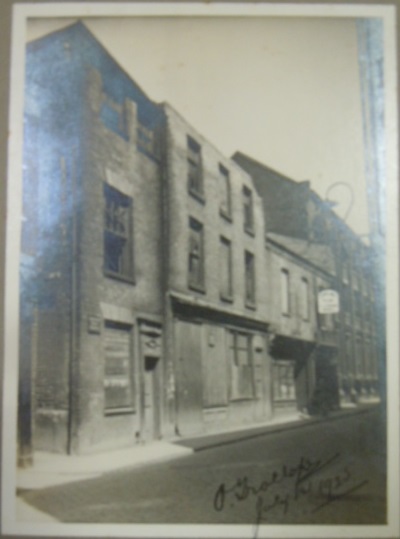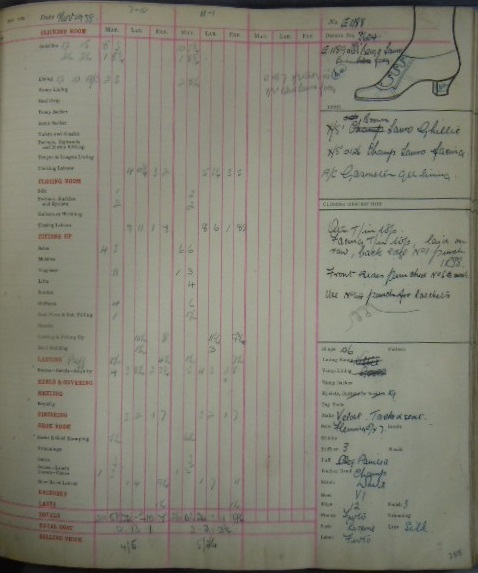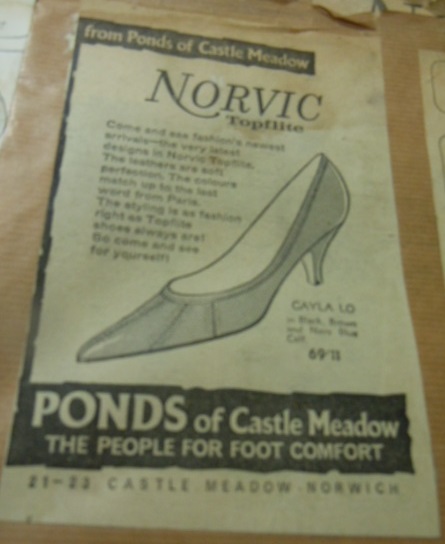EARLY DAYS
In 1846 James Howlett, a farmer, invested £10,000 (a large amount in those days!) into the leather currying business of Robert Tillyard, who was then in rooms on Elm Hill. The investment meant Robert Tillyard could move to larger premises in Princes Street, then Swan Lane, and finally St George’s Plain. This was the beginning of a shoe-making enterprise that was to become famous across the world and later became the Norvic Shoe Company.
In 1857, John Godfrey Howlett, son of James, joined the business, having studied the leather trade. John cut uppers for harness and heavy boots at the factory and within two years had become a travelling sales rep. It was during this period he met his future business partner, George White, son of respected customer Thomas White, whom John had met in Lincolnshire. George joined the company in 1856 as a junior clerk and worked his way to the top, becoming general manager and finally a joint partner with John Howlett in 1876. The firm became Howlett and White and a factory was built to remove the outwork that had been necessary.
FACTORY PLANS
Many plans are available at the Norfolk Record Office which show how the Howlett and White factory developed as expansion took place. The range of plans under the reference BR 35/2/59/17 cover alterations to factory premises for Howlett and White from 1856-1859, 1876, 1894-1895, 1907-1909, 1912, and 1921.

The west elevation plan of the Howlett and White factory, August 1856. Norfolk Record Office: BR 35/2/59/17/29
The west elevation plan shown above, from August 1856, gives a good idea of the extent of the factory at St George’s, as does the first floor plan of the same date (NRO: BR/35/2/59/17/29). The back elevation plan of May 1876, gives a very good idea of the height of the building (NRO: BR 35/2/59/17/32).

A back elevation plan of the Howlett and White factory, May 1876. NRO: BR 35/2/59/17/32
A later first floor plan, dated 12 November 1908, shows an extension of the premises (NRO: BR 35/2/59/17/18).
By the end of the nineteenth century, Howlett and White was one of five companies dominating the shoe industry. The factory at St George’s Plain grew to become one of the great shoe-making centres in the country, employing almost 2,000 people and producing 25,000 pairs of shoes a week.
GENERAL COMPANY INFORMATION
For those interested in learning more about the company of Howlett and White, the Norfolk Record Office holds a range of business records, under the reference BR 114. These records include ledgers, cash books, minute books, design books and pattern books amongst others. They also include a copy of the Partnership Agreement, Articles and Memorandum from 24 February 1885 (NRO: BR 114/1).
Sadly, around 1900, John Howlett retired from daily involvement in the business due to ill health. The sons of John Howlett and George White: Arthur Godfery Howlett, J. Warnes Howlett and G. Ernest White, took on more responsibilities, having been involved in the business since the 1880s. In 1909, they started to use the brand name ‘Norvic’ to market a range of shoes which had 20 different styles. Boots and shoes were sold in 13 sizes with four fittings for each size.
George White died in 1912, aged 72 and was described as the father of the shoe industry.
THE PERIOD OF WORLD WAR ONE
Howlett and White, by now under the control of the sons of the founders, continued to expand. However, the outbreak of World War One had an immediate effect on trade when the company lost most of its overseas market; this accounted for about 30% of total sales. Their large orders for German sports shoes immediately stopped and Howlett and White started to make army boots for both the British Army and other Allied Armies. This reflects how during WWI production across shoe factories in Norwich changed. Previously accustomed to making women’s shoes, they now made hospital slippers, shoes for the Navy, and fur lined boots for the Air Force in addition to army boots. Women replaced the men in the factories as the men were called up.
POST WORLD WAR ONE
Between the two world wars the Norwich shoe industry had to concentrate on the home market, and try to get as large a share as possible, because many of their overseas customers developed their own footwear industries. This was done by strong brand names and advertising. Whilst Howlett & White had previously concentrated on high class ladies shoes, they realised they now needed to produce both men’s and children’s shoes. They achieved this by taking over other shoe companies. In 1922, they took over Oakeshott & Finnemore Ltd, Northampton and by 1929, they had purchased the remainder of the share capital of Nottinghamshire Mansfield Shoe Company Ltd, who catered for the cheaper end of the market. 1934, saw the Norwich company S. L. Witton Ltd added to the list.

The front of the Howlett and White factory, taken by O.Trollope on 01 July 1925. NRO: BR 114/121
By 1935, Howlett and White was the largest footwear manufacturing group in England and was renamed the Norvic Shoe Company Limited, known locally as Norvic. The Norfolk Record Office holds many design and pattern books for shoes made after this period, which show the amount of detail that went into every design.

A photograph of shoe design E1188, dated November 1938. NRO: BR 114/75
Norvic was one of a small number of shoe factories who also had their own retail stores. In 1970 they owned over 140 outlets and these sold about 25% of their shoes. Continuity of production was ensured with a company having its own shops and it is interesting to look at the many advertisements which appeared during the 1950’s which show the wide area of the United Kingdom where Norvic shoes were sold.
Adverts show Norvic shoes were sold as far afield as Bairds of Stirling, Scotland; Maxwell Gray in Hastings and Enoch Edge in Lancaster. NRO: BR 114/125

An advert for Norvic shoes sold in Ponds. BR 114/125
Coming closer to home Norvic shoes were sold in Ponds on Castle Meadow, Norwich “the people for foot comfort”.
Norvic became one of the many Norwich shoe companies to go out of production between 1970 and 1990. Taken over by Drakes in 1972, the chain was sold to William Timpson Ltd who had to sell Norvic shoes for three years. After this period they stopped selling Norvic shoes and in 1981 Norvic folded.
Compiled by Ros Montague, NRO Research Blogger
Information from:
- Norfolk Record Office
- www.heritagecity.org/research-centre/industrial-innovation/howlett-and-white.htm
- Grace’s Guide to British Industrial History
- The Story of the Norwich Boot and Shoe Trade by Frances and Michael Holmes
- A Norvic Century 1846 – 1946 by F. W. Wheldon
















Fascinating article on the Norwich shoe trade. When walking around Norwich it’s surprising to realise how many buildings were dedicated to shoe making and now it has all but disappeared. The NRO was an invaluable resource when I was trying to establish the architect of Haldinstein and Bally’s shoe factory in Queen St. http://wp.me/p71GjT-3lr
LikeLike
Hi Reggie,
I’m glad we were able to help when you were looking into your own research on the shoe factory in Queen Street.
LikeLike
I would lovr to know if workers records are still kept abd were i can see y family
who worked in the shoe industry in norwich. Fròm george francis gfather to eva auntie, percy, a d 10 other francis, plus elsie married russell pratt all worked for shoe
LikeLike
Hi Sue,
We do have business records for various shoe manufacturers, which sometimes include employment records. Do you know which manufacturer they worked for?
LikeLike
I didnt even know they existed until i started doing my family tree, from my grandfather to my aunties and uncles, most worked in shoes, all francis, except russell pratt, who,married an auntie the only one i knew about. If you find anything at all i,would appreciate it.. they livec in yard at least that were my grandparents lived. Thank you so much
LikeLike
Pingback: Norvic | Alfred Gillett Trust
Pingback: The Norwich Way of Death | COLONEL UNTHANK'S NORWICH
Pingback: The Rosary Cemetery, Part I: Black And White Photographs – Tales From The Brazier's Grotto
Sorry swan yard i believe it was called
LikeLike
No reply for me?
LikeLike
Hi Sue, sorry we don’t seem to have all of your message. Our last message asked if you knew which manufacturers they worked at and I don’t seem to have your reply. If you could let me know I will have a quick look in our online catalogue to see if we have the records of that firm. It won’t be able to say if your ancestors were included in the records- you would need to search them yourself. I hope that helps.
LikeLike